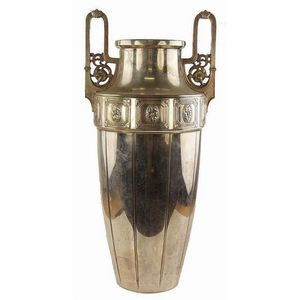Art Deco Silver Urns with Laurel Medallions
You must be a subscriber, and be logged in to view price and dealer details.
Subscribe Now to view actual auction price for this item
When you subscribe, you have the option of setting the currency in which to display prices to $Au, $US, $NZ or Stg.
- Art Deco Period - The Art Deco period was a cultural movement that emerged in the 1920s and 1930s, and was characterized by its emphasis on modernism, luxury, and elegance. The name "Art Deco" comes from the Exposition Internationale des Arts Décoratifs et Industriels Modernes, a large exhibition held in Paris in 1925 that showcased the latest trends in decorative arts.
Art Deco was a reaction against the ornate and elaborate styles of the previous era, and reflected a new modern sensibility. It was characterized by streamlined, geometric shapes, bright colours, and the use of new materials such as chrome, glass, and Bakelite. Art Deco designers sought to create a sense of luxury and sophistication, often incorporating expensive materials such as ivory, marble, and rare woods.
Art Deco had a significant impact on a wide range of artistic fields, including architecture, fashion, graphic design, and interior design. Some of the most iconic examples of Art Deco architecture include the Empire State Building in New York City, the Hoover Building in London, and the Palais de Chaillot in Paris.
The Art Deco period came to an end in the 1940s, as World War II and changing cultural trends led to a shift in artistic styles. However, Art Deco remains an important influence on design and art, and continues to be celebrated for its modernist sensibility and glamorous aesthetic. - Laurel Leaf - The use of the laurel leaf as a decorative element can be traced back to ancient Greece and Rome, where it was closely associated with victory and honour. In these cultures, the laurel was a sacred tree that was dedicated to the god Apollo and was believed to have protective and healing properties.
In ancient Greece, the laurel wreath was awarded to victors in athletic competitions, such as the Olympic Games, as a symbol of their achievement. The wreath was also associated with academic achievement, and was often worn by scholars and poets. The Greeks also used the laurel leaf as a symbol of victory in war, and it was often depicted in artwork alongside images of triumphant warriors and heroes.
The Romans continued this tradition, and the laurel wreath became a symbol of the highest military honor, the triumph, awarded to victorious generals. The wreath was also used to crown emperors and other important officials, and was often depicted in Roman art and architecture as a symbol of power and authority.
The laurel leaf is still used as a symbol of achievement, success, and excellence, and is frequently used in logos, emblems, and other branding materials. Its association with victory and honour has made it a popular choice for awards, medals, and other forms of recognition.
This item has been included into following indexes:
Visually similar items

A fine quality stylish 1950s Danish silver sauce boat, of plain oval section with wide pouring spout, ebonite handle. Impressed marks and dated 1951. Length 19.5 cm

English hallmarked sterling silver amphora vase with two handles. London, 1899, maker William Comyns & Sons weight 267g

A Victorian silver mustard pot, of octagonal section with conforming domed hinged cover, red glass liner with small rim chips. Birmingham 1897 by Yapp & Woodward. Finial bent

An Arts and Crafts sterling silver two handled bowl by B & C, Birmingham 1907, 14 cm wide, 95 grams
